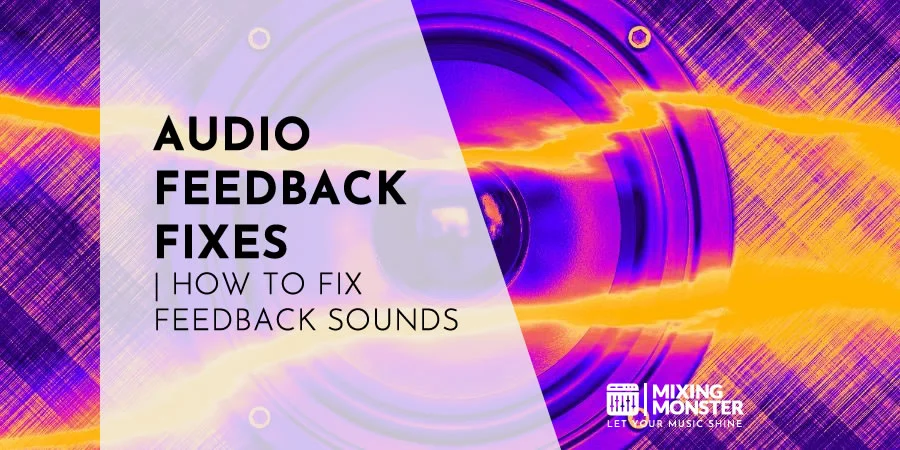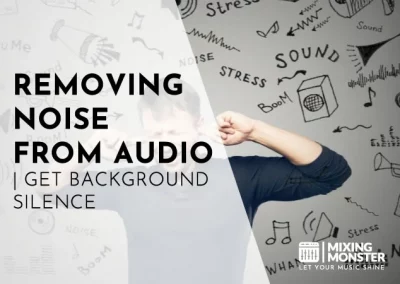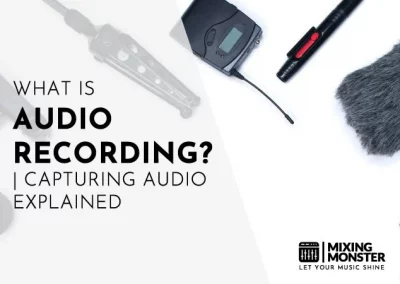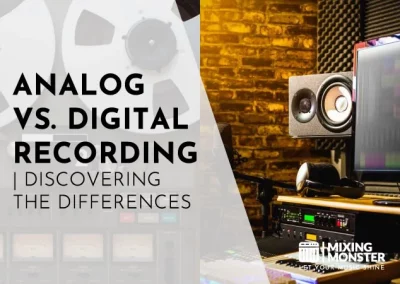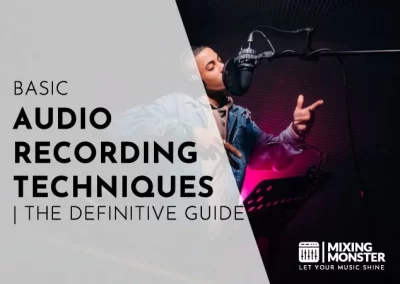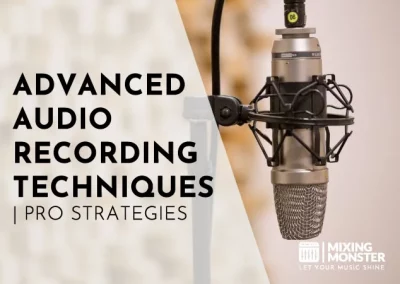Disclosure: Some of the links below are affiliate links, meaning that at no additional cost to you, we will receive a commission if you click through and make a purchase. Read our full affiliate disclosure here.
Audio feedback is a familiar phenomenon that can plague and enhance audio environments. Whether at a concert, conference room, or studio recording, you’ve likely encountered the shrill squeal that abruptly demands everyone’s attention. But what exactly causes this intrusive noise, and how can it be managed or used creatively?
Audio feedback occurs when a sound loop is established between an audio input, such as a microphone, and an audio output, like a speaker. This loop can amplify specific frequencies to create a sustained, ringing sound that ranges from a low drone to a high-pitched screech. It is common in public address systems, musical performances, and recording sessions. Understanding the technical components contributing to feedback can help manage and prevent undesirable effects.
As you delve deeper into this article, you’ll gain valuable insights into diagnosing the root causes of audio feedback, implementing strategies to control it, and learning how some artists deliberately incorporate it into their performances. You’ll also uncover the role of room acoustics and how proper audio management can ensure a precise, feedback-free experience. Prepare to empower yourself with the knowledge to handle audio feedback effectively in any auditory setting.
KEY TAKEAWAYS:
- Audio feedback is an often unwanted sound resulting from a loop between an audio input and output.
- Managing and preventing feedback involves understanding technical components and acoustics.
- Audio feedback can also be used artistically in controlled scenarios for creative effects.
Table Of Contents
1. What Is Audio Feedback?
2. Audio Feedback In Technical Components
3. Managing And Preventing Audio Feedback
4. Artistic Use Of Audio Feedback
5. Acoustics And Venue Dynamics
6. Handling Audio Feedback Properly
7. FAQ

1. What Is Audio Feedback?
Audio feedback occurs when the sound from the audio output is picked up by the audio input and re-amplified, resulting in a potentially loud and screeching sound.
Audio Feedback Explained
Audio feedback is a phenomenon that materializes when the sound from an audio output device, such as a speaker, is recaptured by an audio input device, like a microphone. This inadvertently creates a feedback loop, which, if unchecked, can lead to an increasingly loud and high-pitched oscillation.
Mechanics Of Audio Feedback Loops
The mechanics behind audio feedback loops are rooted in the concept of positive feedback. Each loop begins when a microphone picks up sound amplified and projected by a speaker.
If the microphone captures this amplified sound again, the cycle repeats with increased gain, making the loop stronger and the resulting sound louder with each pass. The frequency at which this happens largely determines the pitch of the feedback heard.
Common Audio Feedback Scenarios
- Live Performances:
When a microphone is too close to a speaker, both are connected to the same amplification system. - Public Speaking:
Similar to live performances, but can also occur in lecture halls and meeting rooms with poorly configured sound systems. - Recording Studios:
High gain levels in recording situations may lead to unintentional feedback if monitors (speakers) and microphones are improperly isolated.
2. Audio Feedback In Technical Components
In this section, you’ll learn about the intricate parts that play a role in audio feedback phenomena within sound systems. From the equipment involved to methods of control, grasp the technicalities that underpin feedback issues and solutions.
Feedback In Audio Equipment
Audio feedback is typically a result of a positive feedback loop where sound from a loudspeaker is picked up by a microphone, amplified by an amplifier, and passed out through the loudspeaker again.
This loop continues and can result in an increasingly loud and often uncomfortable sound. A real-time analyzer may be used to identify feedback frequencies. Strategic microphone placement and choosing the right type of microphone, such as a directional microphone or a dynamic microphone like the Shure SM58, are essential to mitigate feedback.
Similarly, speaker placement is critical, with feedback suppressors sometimes employed for additional control.
- Microphones:
Convert sound into an electrical signal. - Speakers:
Project the sound back into the environment. - Amplifiers:
Boost the electronic signal before it reaches the loudspeaker. - PA System:
Personal or public address systems utilize these components within an audio loop. - Guitar Pickups:
Transduce string vibrations into electrical signals, which can also be fed into the loop.
Acoustic And Electronic Control
Managing feedback involves both acoustic treatment and electronic intervention. Acoustic feedback can be reduced by adjusting the environment or using directional microphones, which minimize the pickup of extraneous sounds.
On the electronics side, graphic equalizers allow you to notch out specific feedback-prone frequencies. High-quality preamps can also enhance the signal-to-noise ratio, reducing the need for excessive amplification, which often contributes to feedback.
Implementing negative feedback within the electronic circuitry in digital audio systems can reduce distortion effects and increase system stability.
- Equalizers (EQs):
Filter out unwanted frequencies; can be graphical or parametric. - Graphic Equalizer:
This represents frequencies graphically and allows for precise adjustments. - Headset:
This can offer a more direct audio input, reducing feedback potential. - Feedback Suppressors:
Detect and reduce feedback electronically. - Negative Feedback:
Applied within electronic circuitry to control and stabilize the system.
3. Managing And Preventing Audio Feedback
Applying practical techniques and advanced strategies focusing on control, frequency response, and volume levels is crucial for effectively handling audio feedback. This ensures clear sound without distortion.
Practical Techniques To Avoid Audio Feedback
- Microphone And Speaker Placement:
Keep your loudspeakers in front of microphones and angle them away to prevent the microphones from picking up amplified sound, a method commonly known as ringing out. - Volume Control:
Manage the gain level and avoid setting too high, as excessive volume can lead to a howling sound or hum. - Sound Checks:
Conduct sound checks before performances to adjust equipment settings and address potential issues early.
Advanced Strategies To Manage Audio Feedback
- Feedback Eliminators:
Implement feedback eliminators that automatically identify and reduce frequencies causing feedback without affecting the overall sound quality. - Barkhausen Stability Criterion:
Understand the Barkhausen stability criterion to assess feedback tendencies and tweak your system accordingly. - Equalizers and Filters:
Use equalizers to attenuate problem frequencies and apply notch filters that target and diminish specific frequencies, causing feedback.
4. Artistic Use Of Audio Feedback
Exploring the realm of audio feedback reveals its dual nature as both a technical phenomenon and an artistic tool. In this section, you will uncover how pioneers like Jimi Hendrix and The Beatles transformed feedback from an acoustic challenge into a means of musical expression.
Historical Perspective Of Audio Feedback
While often seen as an issue, audio feedback found a place in musical history when artists began exploiting it for its unique sound.
The Beatles, for instance, brought feedback to the masses in their 1964 hit “I Feel Fine,” which opens with an intentional feedback sound.
Jimi Hendrix was known to masterfully control feedback to create sustained notes and emotive sounds during his electric guitar performances.
Brian May, with his self-built Red Special guitar, could manipulate feedback by interacting with the resonant frequencies of his instrument, crafting a signature sound that defined Queen’s music production.
Creative Applications Of Audio Feedback
When you shift from a historical lens to contemporary practice, intentional feedback remains a tool for artistic creativity. It can be shaped into a piercing screech or a haunting sustain, as demonstrated in the unique styles of icons like Lou Reed.
Modern musicians and sound artists follow this tradition by incorporating feedback deliberately into their compositions, creating textures and layers that enhance the auditory experience. Whether in live performances or sophisticated studio productions, the strategic use of audio feedback can add depth and character to musical works.

5. Acoustics And Venue Dynamics
In this section, we’ll explore how a venue’s features impact audio feedback and the considerations sound engineers must make during live events.
Audio Feedback Room Acoustic Considerations
When managing the audio at a venue, understanding room acoustics is vital to prevent the Larsen effect, which is the high-pitched noise that occurs when sound waves are picked up by a microphone, amplified, and then emitted through speakers repeatedly to create a feedback loop.
The shape and size of the room, along with its reflecting surfaces, can exacerbate this effect. Sound waves can reflect, absorb, or scatter depending on the materials they encounter, and each room will have a distinct reverberation time affecting the clarity of sound.
As a sound engineer, utilizing Real-Time Analysis (RTA) equipment helps you visualize the room’s frequency response and make appropriate adjustments.
- Sensitivity:
Adjust the microphone’s sensitivity and directional pattern to minimize unwanted feedback. - Flexibility:
Implement equalization (EQ) techniques to attenuate frequencies prone to feedback. - Directionality:
Use directional microphones and speakers to control the flow of sound energy in the venue.
Audio Feedback In Live Events
The stakes are high during live events, and performances can change quickly. This requires your audio setup to be both robust and adaptable. Along with understanding room acoustics, you’ll need to consider the performance aspects, such as the movement of musicians or speakers and any changes to the stage setup.
Each modification can alter how sound waves propagate through space, leading to potential feedback issues. Their pickups can provide feedback if the live event includes instruments, especially electric guitars.
- Nuisance:
Feedback can rapidly become a nuisance, drowning out the intended audio and detracting from the experience. - Real-time adjustments:
Be prepared to make real-time adjustments to the audio mix monitor speaker placement and microphone usage to adapt as the dynamics of the event change.
6. Handling Audio Feedback Properly
When dealing with audio feedback, it’s essential to understand the technical aspects and practical techniques for mitigation. This includes knowing how your room’s acoustics can affect feedback occurrence.
Your environment plays a crucial role in controlling audio feedback. Surfaces in the room can reflect sound, which, in turn, may get picked up by microphones and create a feedback loop.
Key Takeaways Of How To Manage Audio Feedback
- Identify Reflective Surfaces:
Use sound-absorbing materials to address walls, ceilings, and floors that cause sound reflections. - Optimize Speaker Placement:
Point speakers away from the microphones and angle them to minimize direct paths to the microphones. - Microphone Selection and Placement:
Choose directional microphones and position them to favor the sound source and reject other noise. - Monitor Volume Levels:
Keep the amplification within a threshold your space can handle without inducing feedback. - Use Proper Equipment Settings:
Utilize equalizers to notch out frequencies prone to feedback. - Perform a Soundcheck:
Test your setup before a live event to find and fix potential feedback issues. - Consider Room Geometry:
Cur curved and angled surfaces can focus sound and cause feedback issues.
7. FAQ
1) What causes audio feedback in sound systems?
Audio feedback occurs when the sound from an output, such as a speaker, is picked up by an input, such as a microphone, creating a loop that amplifies itself.
2) How can I eliminate feedback from my microphone setup?
To eliminate feedback, move your microphone away from speakers and use directional microphones to pick up less ambient noise.
3) What are common ways to reduce feedback when using speakers?
Reducing feedback can be achieved by placing speakers in front of the microphones and angling them correctly to avoid the sound being directly picked up by microphone inputs.
4) Can particular frequencies contribute to feedback issues?
Specific frequencies are more prone to causing feedback, especially those that resonate naturally with the room or the audio equipment.
5) How do feedback eliminators work in audio equipment?
Feedback eliminators detect frequencies that cause feedback and notch them out or apply a filter to minimize or eliminate them.
6) What does audio feedback typically sound like?
Audio feedback is often recognized as a high-pitched squeal or a low-frequency rumble. It rises in volume if not promptly addressed.

